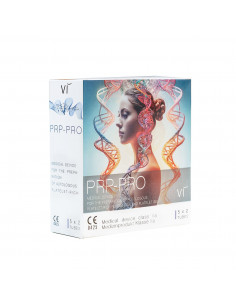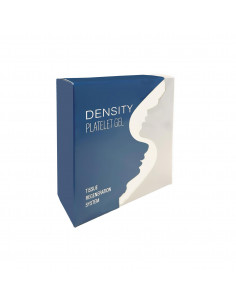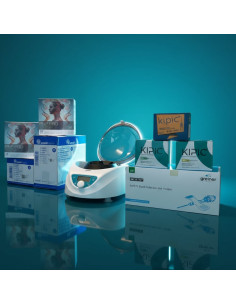PRP treatment
100101
VI PRP-PRO | PRP Tubes – The Revolution in Plasma Treatment
The VI PRP-PRO glass tube offers a modern solution for producing platelet-rich plasma (PRP) and ensures additional stability and reliability in treatments with a wall thickness of 2.4 mm. Developed with innovative technology and EC-certified (0425-MED-004180-00), it guarantees the highest level...
immediately available
€131.00
PRF/PRP Glass Tubes without Anticoagulant or Separation Gel | 9 ml | PU 10 tubes
100104
Glass tubes for PRF/PRP applications without anticoagulants. Free of separation gel and additives, suitable for various PRF protocols in all medical fields as well as for PRP procedures.
These tubes contain no gel and no anticoagulants.
Contents: 10 empty PRF/PRP tubes
immediately available
€99.00
Borosilicate tubes with added melatonin (6 pieces per pack)
100335
PRP tubes with melatonin
Designed for professional use in aesthetic PRP protocols for the scalp.
The inner wall is coated with a defined amount of melatonin (0.0232 mg). Made from high-quality borosilicate glass for obtaining platelet-rich plasma (PRP) of optimal quality.
The vacuum system allows for easy blood collection. Addition of an...
immediately available
€65.00
PRP Starter Set | EBA 200
100400
PRP starter set consisting of:
1x Hettich EBA 200 centrifuge
2x PRP tubes | Vi PRP-Pro PU 10 pcs.
1x KIPIC® needle 25G x 42mm, PU 100 pcs.
1x KIPIC® Mesotherapy Needle 30G 4mm | PU 100 pcs.
1x KIPIC® Mesotherapy Needle 32Gx4mm | PU 100 pcs.
1x Mediware disposable syringes 5ml 3-piece Luer-Lock sterile (PU 100 pcs.)
1x Safety Blood Collection...
immediately available
€1,815.00
PRP Starter Set | SERVOspin Evolve – Complete package for professional users
100451
The PRP Starter Set | SERVOspin Evolve contains all components for precise and reproducible PRP processing.
The set is ideal for medical practices, aesthetic treatments, and laboratories that prefer compact, quiet, and reliable devices.
Contents:
1× SERVOspin Evolve centrifuge 6×15 ml
2× Vi PRP-PRO tubes | 10 pcs.
1× KIPIC® 25G × 42 mm | 100 pcs....
immediately available
€1,199.00
DUO PRF/PRP centrifuge - Class IIa medical device for PRP and PRF therapies
100401
Certified Class IIa medical device – specifically designed for PRF and PRP therapies.
Maximum speed of 4500 RPM and RCF up to 2490 x g for precise and safe blood preparation.
Quiet operation at only 56 dB – ideal for use in quiet clinic or practice environments.
User-friendly controls with pre-set programs and easy parameter adjustments.
Highest...
immediately available
€1,999.00
PRP Power Kit Pro - your complete set for professional PRP treatments
100399
This set includes:
1x DUO Centrifuge2x PRP Tubes | Vi PRP-Pro VPE 10 pcs1x KIPIC® Needle 25G x 42mm, VPE 100 pcs1x KIPIC® Mesotherapy Needle 30G 4mm | VPE 100 pcs1x KIPIC® Mesotherapy Needle 32G x 4mm | VPE 100 pcs1x Mediware Disposable Syringes 5ml 3-part Luer-Lock Sterile (VPE 100 pcs)1x Mediware Disposable Syringes 2/3ml 3-part Luer-Lock Sterile (VPE...
immediately available
€2,399.00










